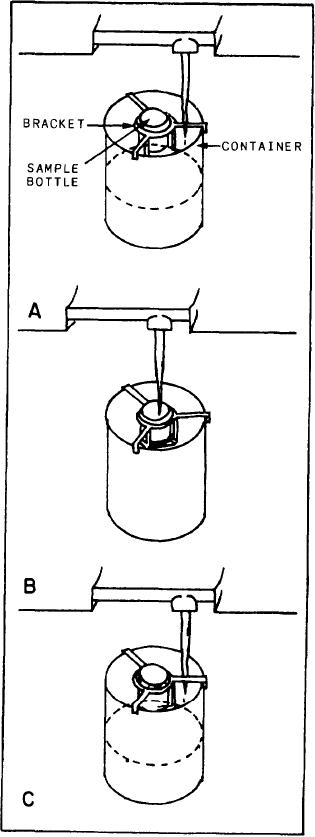
has been filled to about one-half inch from the
top.
WARNING
Do not use mouth suction to fill the
sampling tube. Many oils and fluids are
highly toxic and may cause paralysis or
death.
4. Replace the bottle cap and tighten it to
prevent leakage of the sample. Replace the cap
on the tank and discard the sampling tube.
5. Reduce the chance of misidentifying
samples by marking all oil samples with equip-
ment/system identification as soon as possible
after sampling.
DRAIN SAMPLING.-- When using the drain
sampling method for getting a fluid sample, you
should use the following procedures:
1. Open the sample bottle.
2. Open the drain outlet in the bottom of the
tank, sump, case, or drain port, and allow enough
oil to flow through. This washes out accumulated
sediment. (See fig. 5-19, view A.)
3. Hold the sample bottle under the drain and
fill to about one-half inch from the top. (See
fig. 5-19, views B and C.) Close the drain outlet.
4. Replace the bottle cap and tighten it enough
to prevent leakage.
5. Reduce the chance of misidentifying
samples by marking all oil samples with equip-
ment/system identification as soon as possible
after sampling.
NOAP Forms and Logbook Entries
Activities are also responsible for completing
appropriate forms and making entries in the
equipment logbook.
Proper completion of the Oil Analysis Request
(DD Form 2026) is vital (fig. 5-20). Maintenance
actions or recommendations (table 5-4) are based
on information provided by this form and the oil
sample. Incomplete information (oil added since
last sample, hours since overhaul, etc.) could
result in an invalid oil analysis and recommenda-
tions. The operating activity must also provide
special reports or feedback information requested
by the oil analysis laboratory or the CFA.
Figure 5-19.-Oil drain sample technique.
Logbook entries are necessary when starting,
stopping, or changing the monitoring laboratory
for oil analysis. A specific notation is also made
5-24

